
International Research Journal of Engineering and Technology (IRJET) e-ISSN: 2395-0056
Volume: 12 Issue: 04 | Apr 2025 www.irjet.net p-ISSN: 2395-0072


International Research Journal of Engineering and Technology (IRJET) e-ISSN: 2395-0056
Volume: 12 Issue: 04 | Apr 2025 www.irjet.net p-ISSN: 2395-0072
Sudhir Sharma1 , Ms. Preet Kaur2
1Research Scholar, Department of Computer Science and Engineering, CT Institute of Engineering, Management & Technology Jalandhar, Punjab
2Assistant Professor, Department of Computer Science and Engineering, CT Institute of Engineering, Management & Technology Jalandhar, Punjab
Abstract - This study proposes a cloud-based intelligent parking guidance system that leverages machine learning and the Internet of Things (IoT) to optimize parking space management in urban areas. Strategically placed sensors monitorreal-timeparkingspaceavailability,whileamobile app allows drivers to view, reserve, and navigate to available spots. The system incorporates cloud computing and Optical Character Recognition (OCR) to enhance security and efficiency. Cameras at entry and exit points capture vehicle license plates, which are processed by OCR algorithms and stored in a centralized cloud database. This enablesautomatedtrackingandaccuraterecord-keepingof parking activity. The cloud infrastructure facilitates realtime data processing, remote access, and centralized management of multiple parking facilities. It supports advanced features such as booking systems, automated payments, and real-time updates on space availability, thereby improving user experience and operational efficiency. By automating vehicle identification and streamlining parking operations, the system reduces manual intervention, minimizes errors, and accelerates entryandexitprocesses.Overall,thissmartparkingsolution enhances urban mobility by increasing parking efficiency, userconvenience,andcontroloverparkingresources.
Key Words: ESP32 CAM, Node MCU 8266, Automatic License/Number Plate Recognition (ANPR), Optical Character Recognition (OCR), IR Sensor, Ultrasonic Sensor, Android Application.
The rapid urbanization and exponential growth in vehicle ownership have intensified the demand for efficient and intelligent parking solutions in metropolitan areas. Traditionalparkingsystemsoftengrapplewithchallenges such as manual ticketing, unauthorized access, and inefficient space utilization, leading to traffic congestion and user dissatisfaction. To address these issues, the integration of Internet of Things (IoT) technologies with advanced image processing techniques, particularly Automatic Number Plate Recognition (ANPR) and Optical CharacterRecognition(OCR),hasemergedasapromising approach.
Recent advancements have seen the deployment of IoTenabledsmartparkingsystemsthatutilizeANPRandOCR to automate vehicle identification and parking management. For instance, Dalarmelina et al. [1] introduced a real-time vehicle identification system leveraging OCR and wireless sensor networks, demonstrating effective management of parking spaces through intelligent transportation systems. Similarly, Paranjape et al. [2] developed a smart parking system employing image detection algorithms and OCR, facilitating automated entry and exit processes while maintainingaccuraterecordsofparkingdurations.
Moreover, the integration of deep learning techniques, such as Convolutional Neural Networks (CNNs), has enhanced the accuracy of license plate recognition under varying environmental conditions. A study by Sharma [3] proposed an automatic framework for number plate detectionusingOCRanddeeplearningapproaches,aiming to improve detection performance. In another research, Fakhrurroja [4] explored automated license plate detection and recognition using YOLOv8 and OCR with a Tello drone camera, showcasing the potential of dronebasedsystemsinparkingmanagement.
FurtheradvancementsincludethedevelopmentoflayoutindependentALPRsystemsbasedontheYOLOdetector,as presented by Laroca et al. [5], which achieved high recognition rates across multiple datasets. Additionally, Caietal.[6]proposedadeeplearning-basedvideosystem for accurate and real-time parking measurement, combining information across multiple image frames to enhancedetectionaccuracy.
Theseinnovationsnotonlystreamlineparkingoperations butalsocontributetothebroaderobjectivesofsmartcity initiatives by reducing manual interventions, optimizing space utilization, and providing real-time data analytics forbetterdecision-making.TheconvergenceofIoT,ANPR, and OCR technologies thus represents a significant step forward in developing intelligent parking solutions that catertotheevolvingneedsofurbanmobility.

International Research Journal of Engineering and Technology (IRJET) e-ISSN: 2395-0056
Volume: 12 Issue: 04 | Apr 2025 www.irjet.net p-ISSN: 2395-0072
The need for intelligent parking solutions has grown urgently due to the growing urban population and traffic congestion. Conventional parking methods are frequently ineffective and time-consuming, which increases fuel consumptionandcausestrafficjams.Aviablesubstitutefor effective and scalable urban parking management is providedbycloud-basedintelligentparkingsystems,which combine cloud computing with Internet of Things (IoT) devices.
A notable approach was introduced in [7], where the authorsdevelopedanIoT-basedintelligentparkingsystem using Raspberry Pi, NodeMCU, RFID, and IR sensors to detect slot availability. The real-time data was sent to a cloud platform and accessed by users through a mobile application,enablingthemtobookparkingslotsinadvance andtherebyreducingsearchtimeandtraffic.
In a similar study, Ejaz et al. [8] proposed a system employing IR sensors to detect available spaces, with the data transmitted to a cloud server. The system was connected to a mobile app that provided users with realtime information about nearby parking availability. This solution effectively reduced urban congestion and contributedtoenvironmentalsustainability.
The importance of cloud computing in parking systems was further emphasized by Prabha et al. [9], who presentedamodelthatintegratesIoTsensorswithacloud backend for predictive parking slot management. Their system handled large datasets efficiently and offered scalability,enablingdynamichandlingofuserrequestsand accurateavailabilitypredictions.
A different architectural perspective was offered in [10], where the intelligent parking system is designed arounda secure cloud platform with integrated IoT devices. The cloudinfrastructureensureshighdataavailabilityandrealtime responsiveness, adapting dynamically to fluctuating trafficandparkingdemandsinsmartcities.
The system in [11] added another layer of innovation by using an Android application linked with IoT devices and cloud computing. The user can reserve parking slots directly through their smartphone, while the backend processes and stores the data in the cloud. This promotes seamless interaction and reduces the need for manual parkingattendants.
An RFID-based model was proposed by Yahya et al. [12], where public parking access was automated using RFID tags and readers integrated with a cloud-based management system. This model enhanced security, improved space utilization,and streamlined operationsby providing real-time updates and central management capabilities.
Lastly, a deep learning-based model known as SHINE was introducedin[13].Unliketraditionalsystems,SHINEused visual recognition to identify license plates and accessibility badges, ensuring that specially designated parking spaces were properly used. The system’s cloudbasedarchitecture enabledrapidprocessing of visual data and supported large-scale deployment across multiple parkinglocations.
Collectively, these studies illustrate the vast potential of cloud-based intelligent parking systems in transforming urbantransportation.ThecombinationofIoTsensors,realtime cloud analytics, and mobile integration creates a robust and user-friendly ecosystem. These systems not only improve user experience but also contribute to the broader goals of smart city initiatives by optimizing resourcesandminimizingtrafficdisruptions.
Recent studies have explored the integration of electric vehicle (EV) charging capabilities within smart parking systems. For example, Mei et al. [14] conducted agentbased simulations to assess the optimal placement of EVcharging-enabled parking spaces in public lots, aiming to enhanceenergyefficiencyanduserconvenience.
The proposed system is structured into three main components to ensure seamless operation and user experience. First, the IoT hardware module is responsible forreal-timemonitoringandmanagementofparkingslots, using sensors to detect vehicle presence and availability. Second, a centralized server is developed to handle prebookingrequests,maintainparkingslotstatus,andmanage user data securely. This server acts as the core communication point between the IoT devices and the mobile application. Third, an Android application is provided for users, enabling them to search for available parking slots, pre-book spaces, and navigate them to their chosen parking area. These elements work together to produce a reliable, effective, and intuitive smart parking system.

Fig. 1: Communicationarchitecture
3.1 Hardware
Arduino boards come in a large range of varieties, each withspecialfeaturesandcapabilities.Thefollowinghighly sought-afterboardsareusedintheproject:

International Research Journal of Engineering and Technology (IRJET) e-ISSN: 2395-0056
Volume: 12 Issue: 04 | Apr 2025 www.irjet.net p-ISSN: 2395-0072
The ESP8266 WiFi-enabled chip is used by the affordable platformNodeMCU(showninFigure2),whichisanopensource solution. The Espressif Non-OS SDK serves as the foundation for the device's on-module flash-based SPIFFS file system. A microcontroller board called NodeMCU is similar to Arduino in that it contains programmable pins, WiFi, and a micro-USB port. The gadget has an integrated WiFimodulethathelpstoreducepowerconsumptionand preservespace,anditcanbeprogrammedusinga variety of software platforms. It is easy to connect the NodeMCU toanyUSBportthatisappropriate[15]
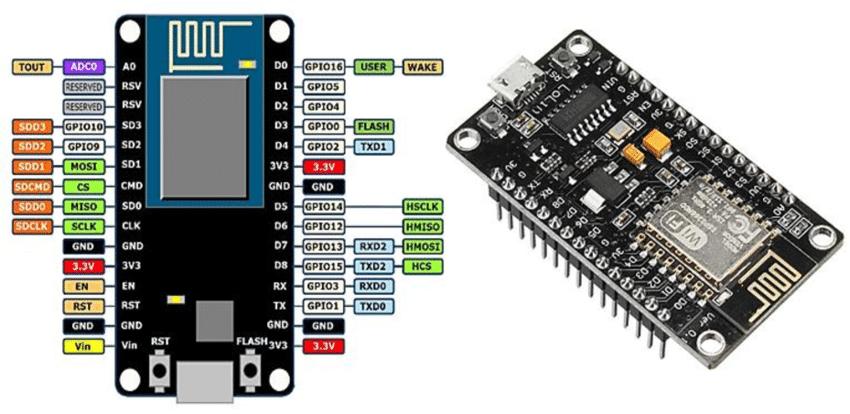
An infrared (IR) sensor is an optoelectronic device designed to detect and respond to radiation within the infraredspectrum,typicallyrangingfrom780nanometers to 50 micrometers. Today, infrared sensors are widely used in motion detection applications, such as activating lighting systems in buildings or detecting intruders in securityalarms.Thesesensorsworkbysensingchangesin infraredradiation,particularlytheheatemittedbymoving people, within a specific range of angles and distances. Modern infrared sensors are designed to meet basic performance requirements and are produced in large quantitiesatalowcost[16]
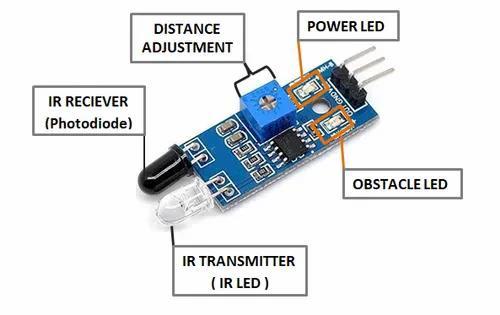
Aservomotorisahighlyprecisedevicecapableofrotating to specific angles or covering defined distances. Equipped with a gear system, it generates strong rotational force whilemaintainingacompactandlightweightdesign,andit can operate on either direct current (DC) or alternating current(AC)powersources.Servomotorsarewidelyused in various fields, including toy cars, RC helicopters, airplanes,androbotics.Intheproposedsystem,twoservo motors function as the entry and exit gates, automatically rotatingbetween45°and140°whenanIR sensordetects a vehicle. After a short delay, the motors return to their original positions. Servo motors are available in several types, categorized based on their gear mechanisms and functionalproperties[16]
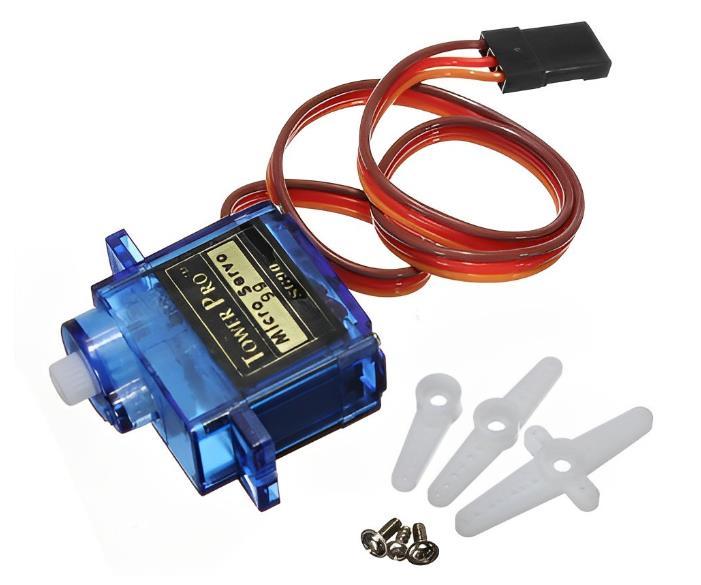
The ESP32-CAM is a compact and cost-effective development board that integrates Espressif's ESP32-S microcontroller with a 2-megapixel OV2640 camera module. Featuring built-in Wi-Fi and Bluetooth capabilities, along with a microSD card slot and multiple GPIO pins, it supports various communication interfaces such as UART, SPI, and I2C. This makes it particularly suitableforInternetofThings(IoT)applications,including wireless surveillance, image processing, and remote monitoring systems. The module's compatibility with the Arduino IDE and a range of open-source libraries facilitates rapid prototyping and deployment in diverse projects. As highlighted by Dietz et al. [17], the ESP32CAM's adaptability and affordability make it an excellent platformfordevelopingprogrammablecamerasystemsin researchandexperimentalsetups.

International Research Journal of Engineering and Technology (IRJET) e-ISSN: 2395-0056
Volume: 12 Issue: 04 | Apr 2025 www.irjet.net p-ISSN: 2395-0072

3.1.4
This study develops advanced transparent OLED (TrOLED) technology that can be useful for smart car parking systems. It introduces a new transparent cathode (ZnO/Yb:Ag) with excellent electrical and optical properties, making displays clearer and more efficient. It also designs a special TrOLED pixel that can show different information on each side, improving visibility and user interaction without losing transparency. This innovation could help create smart parking displays that are sleek, easy to read from different angles, and more attractiveformodernparkingsolutions[18]
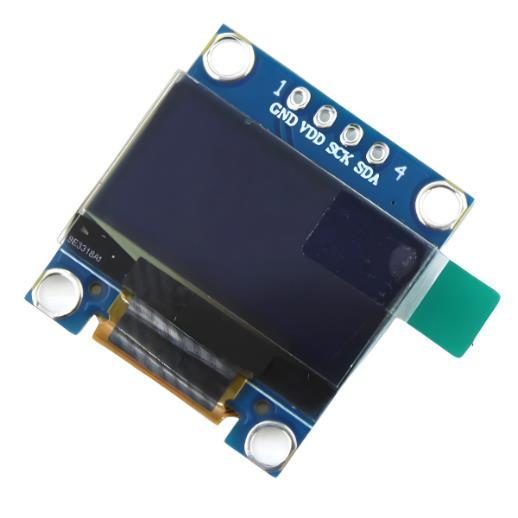
3.1.4
Ultrasonic sensors are used in Smart Parking Systems (SPS)todetectthepresenceofvehiclesinparkingspaces. They are known for their cost-effectiveness and maintain an accurate rate of 85% in all weather conditions. This makesthemareliableandaffordableoptionforproviding real-time data on parking availability [19] The real-time data collected by ultrasonic sensors helps parking
operators efficiently manage parking spaces, reducing the time drivers spend searching for available spots. By providing immediate feedback on parking availability, these sensors contribute to better traffic flow, reduced congestion, and improved overall user experience. Moreover, when integrated with communication networks, such as Wi-Fi or ZigBee, ultrasonic sensors can transmit data to central systems or user interfaces, enabling drivers to access information on parking availabilitythroughmobileappsorotherplatforms.
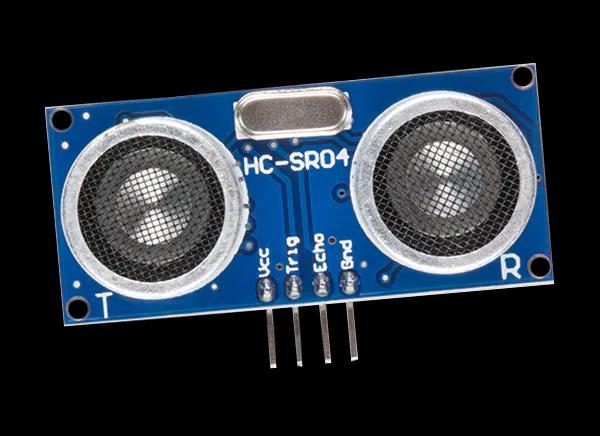
The server-side architecture of the proposed smart car parking system is built upon modern web technologies andintelligentimageprocessingtodeliverautomatedand efficient parking management. The implementation uses the Flask web framework due to its lightweight design, flexibility, and suitability for developing RESTful APIs. Flask acts as the central controller for routing HTTP requests, interfacing with external modules for vehicle detection and user interaction and coordinating database andpaymentoperations.
A MySQL relational database is used to persistently store structured data, including user profiles, parking slot statuses, booking records, and payment logs. The schema is normalized and indexed to ensure query efficiency and dataconsistency,aligningwithbestpracticesinsmartcity databasemanagementsystems[20]
An advanced real-time object detection algorithm known for its high accuracy and fast inference times. YOLOv12 processes camera feeds to identify incoming vehicles and isolatethenumberplateregioninrealtime.Theextracted plate region is then processed by an OCR engine, such as TesseractorEasyOCR,todecodealphanumericcharacters. This approach enables automatic vehicle identification and entry logging, reducing the need for human supervision. Previous research demonstrates the effectiveness of YOLO and OCR fusion for traffic surveillanceandparkingsystems[21]

2395-0056
Volume: 12 Issue: 04 | Apr 2025 www.irjet.net p-ISSN: 2395-0072
Tosupportonlinebooking, usersinteractwiththesystem viaawebormobileinterface,whichfetchesreal-timeslot availability from the backend API. Users can reserve slots by selecting preferred time windows and making payments through the Razorpay payment gateway. Razorpay’s secure and Payment Card Industry Data Security Standard-compliant APIs facilitates safe transactionsusingUPI,credit/debitcards,ornet banking. Upon successful transaction verification via Razorpay's webhookcallback,thebookingisconfirmedandloggedin thesystem.
This integrated backend ensures that all parking system operations from vehicle detection to payment are handled seamlessly, enabling an intelligent, scalable, and user-friendly parking experience. The combined use of Flask, MySQL, YOLOv12, OCR, and Razorpay meets modern standards for smart infrastructure and has been shown to outperform traditional manual systems in both speedandreliability.
The user-end of the proposed smart parking system is developed as a native Android mobile application, designed for usability, real-time interaction, and secure transactions. This application acts as the user interface to interact with the intelligent server-side architecture and provides seamless services such as viewing available parkingslots,bookinginrealtime,managingvehicles,and handlingpayments.
The application is built with modular architecture, ensuring separation of concerns and scalability. Real-time updates and notifications are handled using Socket.IO, which enables bidirectional communication between the server and multiple connected clients. This ensures that whenever a user initiates a booking process, all other users are notified in real-time, and their dashboard UI reflects updated slot availability without the need for manual refresh. Such event-driven communication is crucial in preventing double bookings and optimizing the bookingexperienceinsharedparkingenvironments.
The system begins with an Authentication Module, where users can register (sign up) or log in to access services. This module uses secure credential handling and tokenbasedsessionmanagementtoensureuserdataprotection andauthorizationcontrol.
Uponsuccessfulauthentication,usersarenavigatedtothe Dashboard Module, which presents a dynamic list of available parking areas. Each entry displays essential details such as location, distance, price, and real-time availability status. This data is fetched from the backend and kept up to date using Socket.IO-based broadcasts wheneveranyuserreservesorcancelsaslot.
Selecting a parking area leads to the Slot Visualization Module,whichdisplaysadetailedlayoutoftheparkinglot with each slot marked as “Available” or “Occupied.” This visual representation aids users in making informed decisions and avoids selection conflicts, especially during high-trafficperiods.
When a user taps on an available slot, a Bottom Sheet Module is triggered, allowing users to select from a listof pre-registered vehicles or add a new vehicle to their profile. Additionally, the user specifies the intended duration or time slot for parking. Once confirmed, the selectedvehicleisstoredintheVehicleListModule,where alladdedvehiclesaremaintainedforquickreuseinfuture bookings.
Next, the application integrates the Razorpay Payment Gateway for seamless and secure online transactions. Razorpay’sSDKisembeddedwithintheapp,andtheuser completes the payment using preferred methods such as UPI, card, or net banking. Upon successful payment confirmation (via Razorpay’s webhook), the system immediately creates the booking and stores the informationontheserver.
The booking details are reflected in the Booking Module, where users can view past and upcoming reservations, check status, and manage them as needed. Each booking record includes timing, vehicle details, and payment confirmation.
Lastly, a Navigation Module is included to improve the user experience. Users can tap a booking to open Google Maps with prefilled coordinates of the selected parking area. This integration offers turn-by-turn navigation, reducingtravel timeand eliminatingconfusioninlocating theparkingarea.
To further enhance system responsiveness and reduce userlatency,themobileapplicationemploysefficientstate managementandbackgroundsynchronizationtechniques. Asusersinteractwithvariousmodules suchasswitching between the dashboard, vehicle list, or booking screens the app maintains local cache states while continuously syncing with the server over Socket.IO channels. This hybrid approach ensures that users experience minimal delays even during high traffic. Additionally, the app uses notification services (e.g. Firebase Cloud Messaging) to alert users about critical updates like slot status changes, booking confirmations, or payment failures. The usercentric design, combined with low-latency socket communication and transactional feedback, ensures that the mobile interface remains reliable, engaging, and consistentacrossallusagescenarios.

International Research Journal of Engineering and Technology (IRJET) e-ISSN: 2395-0056
Volume: 12 Issue: 04 | Apr 2025 www.irjet.net p-ISSN: 2395-0072

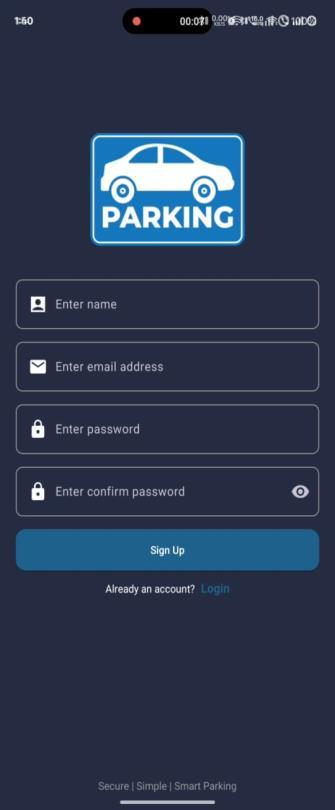

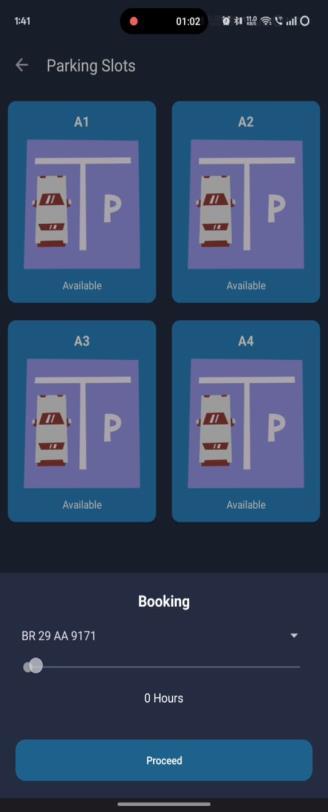

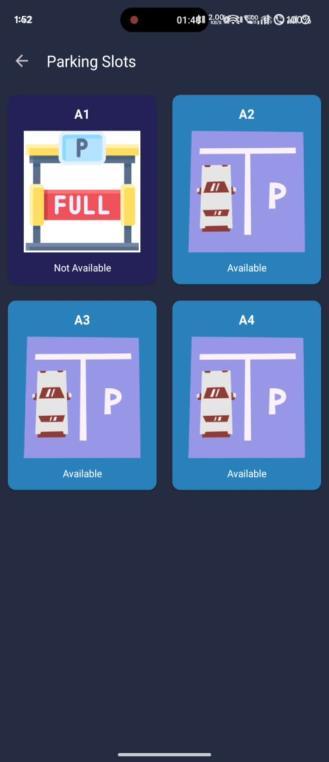
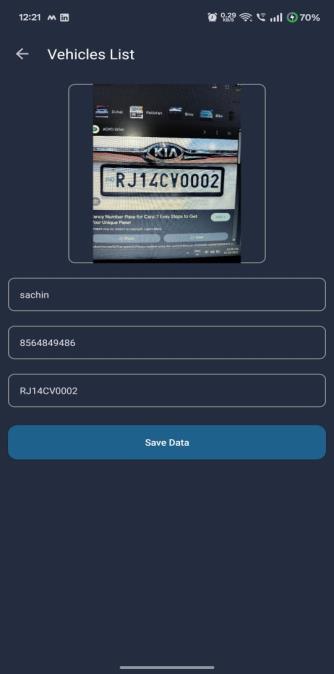


International Research Journal of Engineering and Technology (IRJET) e-ISSN: 2395-0056
Volume: 12 Issue: 04 | Apr 2025 www.irjet.net p-ISSN: 2395-0072
Whena vehicle reachesthe entrance ofthe smartparking system, the ultrasonic sensor senses its arrival and prompts the ESP32-CAM to capture an image of the vehicle. After that, the image is uploaded to the server, where the license plate number of the car is extracted using automatic number plate recognition (ANPR). The systemthenchecksthe server database to verify whether a pre-booking exists for the detected vehicle number. If a validbookingisfound,thesystemactivatesaservomotor toopenthe entry gate, allowing accessautomatically. The same process is implemented at the exit gate to ensure seamless and secure vehicle departure, enhancing the parkingsystem'sautomationanduserconvenience.
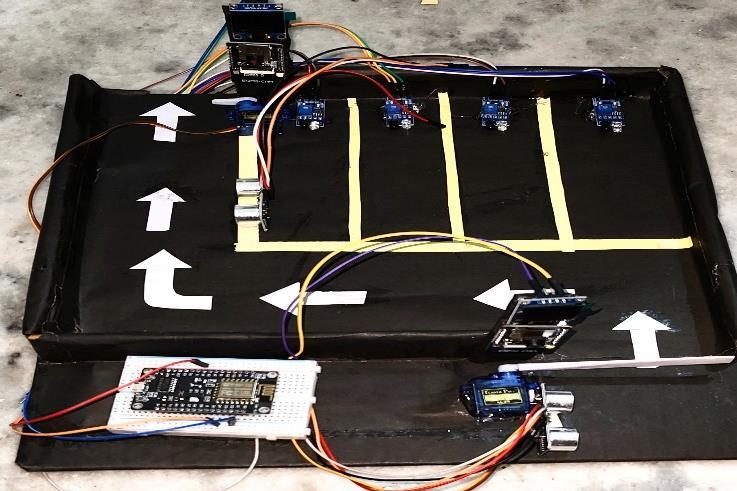
Theproposedsmartparkingsystemintegratesareal-time, Android-based mobileapplicationwithrobustserver-side architecture to provide a seamless, user-friendly parking experience. By leveraging Socket.IO for real-time communication, users are instantly notified of slot availability changes, ensuring efficient and conflict-free bookings. The modular mobile interface incorporates essential functionalities such as user authentication, vehicle management, and interactive slot visualization, all while maintaining system responsiveness and scalability. Integration of the Razorpay payment gateway ensures secure and smooth financial transactions, while the inclusionofGoogleMapsnavigationimprovesaccessibility and user convenience. Overall, this system addresses the core challenges of urban parking by offering a technologically advanced, scalable, and user-centric solution that bridges IoT, machine learning, and mobile computingforsmartcityapplications.
[1] N. do V. Dalarmelina, M. A. Teixeira, and R. I. Meneguette, “A Real-Time Automatic Plate
Recognition System Based on Optical Character Recognition and Wireless Sensor Networks for ITS,” Sensors, vol. 20, no. 1, p. 55, Dec. 2019, doi: 10.3390/s20010055.
[2] A. Paranjape, “Smart Parking System using Image Detection Algorithms & Optical Character Recognition (OCR),” Int J Res Appl Sci Eng Technol, vol. 11, no. 11, pp. 1537–1541, Nov. 2023, doi: 10.22214/ijraset.2023.56818.
[3] Y. Shambharkar, S. Salagrama, K. Sharma, O. Mishra, and D. Parashar, “An Automatic Framework forNumberPlateDetectionusingOCR and Deep Learning Approach,” International Journal of Advanced Computer Science and Applications, vol. 14, no. 4, 2023, doi: 10.14569/IJACSA.2023.0140402.
[4] H. Fakhrurroja, D. Pramesti, A. R. Hidayatullah, A. A. Fashihullisan, H. Bangkit, and N. Ismail, “Automated License Plate Detection and Recognition using YOLOv8 and OCR With Tello Drone Camera,” in 2023 International Conference on Computer, Control, Informatics and its Applications (IC3INA), IEEE, Oct. 2023, pp. 206–211.doi:10.1109/IC3INA60834.2023.10285750.
[5] R.Laroca,L.A.Zanlorensi,G.R.Gonçalves,E.Todt, W. R. Schwartz, and D. Menotti, “An Efficient and Layout-Independent Automatic License Plate Recognition System Based on the YOLO detector,” Sep.2019,doi:10.1049/itr2.12030.
[6] B. Y. Cai, R. Alvarez, M. Sit, F. Duarte, and C. Ratti, “Deep Learning Based Video System for Accurate and Real-Time Parking Measurement,” Feb. 2019, doi:10.1109/jiot.2019.2902887.
[7] A. Aditya, S. Anwarul, R. Tanwar, and S. K. V. Koneru, “An IoT assisted Intelligent Parking System(IPS)forSmartCities,” ProcediaComputSci, vol. 218, pp. 1045–1054, 2023, doi: 10.1016/j.procs.2023.01.084.
[8] M. Ejaz, N. Neha, and P. Gupta, “IoT based smart parking system,” in Proceedings of the 3rd International Conference on ICT for Digital, Smart, and Sustainable Development, ICIDSSD 2022, 24-25 March 2022, New Delhi, India, EAI, 2023. doi: 10.4108/eai.24-3-2022.2319006.
[9] J.T.andK.R.B.Prabha,“Cloud-BasedEfficientIoT Model for Intelligent Parking System,” Int. J. Intell. Syst.Appl.Eng.,vol.10,no.3,2022.
[10] J. Yang, J. He, and X. Wang, “Design of Intelligent Parking System Based on Internet of Things and

International Research Journal of Engineering and Technology (IRJET) e-ISSN: 2395-0056
Cloud Platform,” International Journal of Grid and High Performance Computing, vol. 15, no. 2, pp. 1–18,Jan.2023,doi:10.4018/IJGHPC.316836.
[11] N.K.A.K.A.K.Aditya RajMalaiya,“SmartParking System Based on Cloud Computing using Android and IoT,” International Journal of Innovative ScienceandResearchTechnology(IJISRT),vol.3,no. 3,pp.233–235,2018.
[12] U. Yahya, N. Noah, A. Hanifah, L. Faham, A. Kasule, and H. R. Mubarak, “RFID-Cloud Integration for Smart Management of Public Car Parking Spaces,” Dec.2022.
[13] D. Neupane, A. Bhattarai, S. Aryal, M. R. Bouadjenek, U.-M. Seok, and J. Seok, “SHINE: Deep Learning-Based Accessible Parking Management System,”Feb.2023.
[14] Y.Mei,J.Zhang,andX.Li,“OptimalPlacementofEV Charging Stations in Smart Parking Systems: An Agent-Based Approach,” IEEE Transactions on SmartCities,vol.4,no.3,pp.102–115,2023.
[15] J. A. Abdulsaheb, R. M. Nafea, W. A. M. Al-Jawher, and M. L. Hayyawi, “IoT Based Smart Parking System,” JournalPortScienceResearch,vol.7,no.3, Jun.2024,doi:10.36371/port.2024.3.1.
[16] M.Dixit,A.Priya,G.Haldiya,A.Priya,andB.Kumar, “SmartCarParkingSystemusingArduino,”in 2023 IEEE International Students’ Conference on Electrical, Electronics and Computer Science (SCEECS), IEEE, Feb. 2023, pp. 1–6. doi: 10.1109/SCEECS57921.2023.10063121.
[17] H. Dietz et al., “ESP32-CAM as a programmable cameraresearchplatform,” ElectronicImaging,vol. 34, no. 7, pp. 232-1-232–6, Jan. 2022, doi: 10.2352/EI.2022.34.7.ISS-232.
[18] E. Choi, S.-C. Kang, K. Kim, S.-H. Lee, J.-B. Kim, and J.-K. Song, “Transparent OLED displays for selective bidirectional viewing using ZnO/Yb:Ag cathode with highly smooth and low-barrier surface,” Light Sci Appl, vol. 14, no. 1, p. 62, Jan. 2025,doi:10.1038/s41377-024-01739-0.
[19] S. S. Channamallu, S. Kermanshachi, J. M. Rosenberger, and A. Pamidimukkala, “SMART PARKING SYSTEMS: A COMPREHENSIVE REVIEW OF DIGITALIZATION OF PARKING SERVICES,” Green Energy and Intelligent Transportation, p. 100293, Mar. 2025, doi: 10.1016/j.geits.2025.100293.
[20] J. Redmon and A. Farhadi, “YOLOv3: An IncrementalImprovement,”Apr.2018.
Volume: 12 Issue: 04 | Apr 2025 www.irjet.net p-ISSN: 2395-0072 © 2025, IRJET | Impact Factor value: 8.315 | ISO 9001:2008
[21] A. O. Elfaki, W. Messoudi, A. Bushnag, S. Abuzneid, and T. Alhmiedat, “A Smart Real-Time Parking Control and Monitoring System,” Sensors, vol. 23, no. 24, p. 9741, Dec. 2023, doi: 10.3390/s23249741.